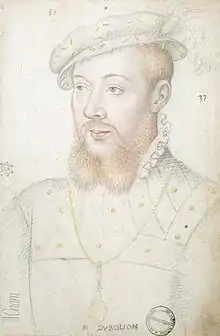Robert IV de La Marck
Robert IV de La Marck (1491, Sedan, Ardennes, 15 January 1512 – Guise, 1556), was Duke of Bouillon, Seigneur of Sedan and a Marshal of France.

Biography
He was the only son of Robert III de La Marck and Guillemette de Sarrebruck.
Aged 17, he became captain of the Swiss Guards. In 1547 King Henry II made him a Marshal of France, and sent him to Rome as French Ambassador. In 1549 he would claim Sedan as a Principality, his son later styling himself as Prince of Sedan.[1] In 1552, he participated in the Siege of Metz and took back possession of his Duchy of Bouillon, which had been occupied by the troops of Charles V, Holy Roman Emperor since 1521. Despite its occupation it would not be returned to the family in the Peace of Cateau Cambresis.[2]
As Lieutenant General in Normandy, he was made prisoner in Hesdin in July 1553. He would be kept in prison and badly treated in Flanders until the Treaty of Vaucelles of February 1556 under which he was released for a ransom of 60,000 écus.[3]
Soon after his release he died, presumably poisoned before his release, on the orders of Charles V.
He is buried at the Eglise Saint-Laurent in Sedan.
Marriage and children
He married in 1538 with Françoise de Brézé, daughter of Louis de Brézé and Diane de Poitiers.[4] They had:
- Henri Robert (1539–1574), Duke of Bouillon and Prince of Sedan, married Françoise de Bourbon, daughter of Louis, Duke of Montpensier.
- Charles Robert (1541–1622), Count of Maulévrier.
- Christian, died young.
- Antoinette (1542–1591), married Henri I de Montmorency.
- Guillemette (1543–1544)
- Diane (born 1544), married 1) Jacques de Clèves, duc de Nevers,[5] 2) Henri de Clermont,[5] 3) Jean Babou, Count of Sagonne.
- Guillemette (1545–1592), married John III, Count of Ligny
- Françoise (born 1547), abbess
- Catherine (born 1548), married Jacques de Harlay, seigneur de Champvallon
References
- Carroll, Stuart (2013). "Nager entre deux eaux: The Princes and the Ambiguities of French Protestantism". Sixteenth Century Journal. 44 4: 991.
- Carroll, Stuart (2013). "'Nager entre deux eaux': The Princes and the Ambiguities of French Protestantism". Sixteenth Century Journal. 44 4: 998.
- Carroll, Stuart (2013). "'Nager entre deux eaux': The Princes and the Ambiguities of French Protestantism". Sixteenth Century Journal. 44 4: 998.
- Carroll 1998, p. 20.
- Potter 1990, p. 23.
Source
- Carroll, Stuart (1998). Noble Power During the French Wars of Religion: The Guise Affinity and the Catholic Cause in Normandy. Cambridge University Press.
- Potter, David (1990). "Marriage and Cruelty among the Protestant Nobility in Sixteenth-Century France: Diane de Barbançon and Jean de Rohan, 1561-7". European History Quarterly. Volume: 20 issue: January 1: 5–38. doi:10.1177/026569149002000101.
- Pierre Congar, Jean Lecaillon et Jacques Rousseau, Sedan et le pays sedanais, vingt siècles d’histoire, Paris, Guénégaud, 1969 ; Marseille, Laffitte Reprints, 1978